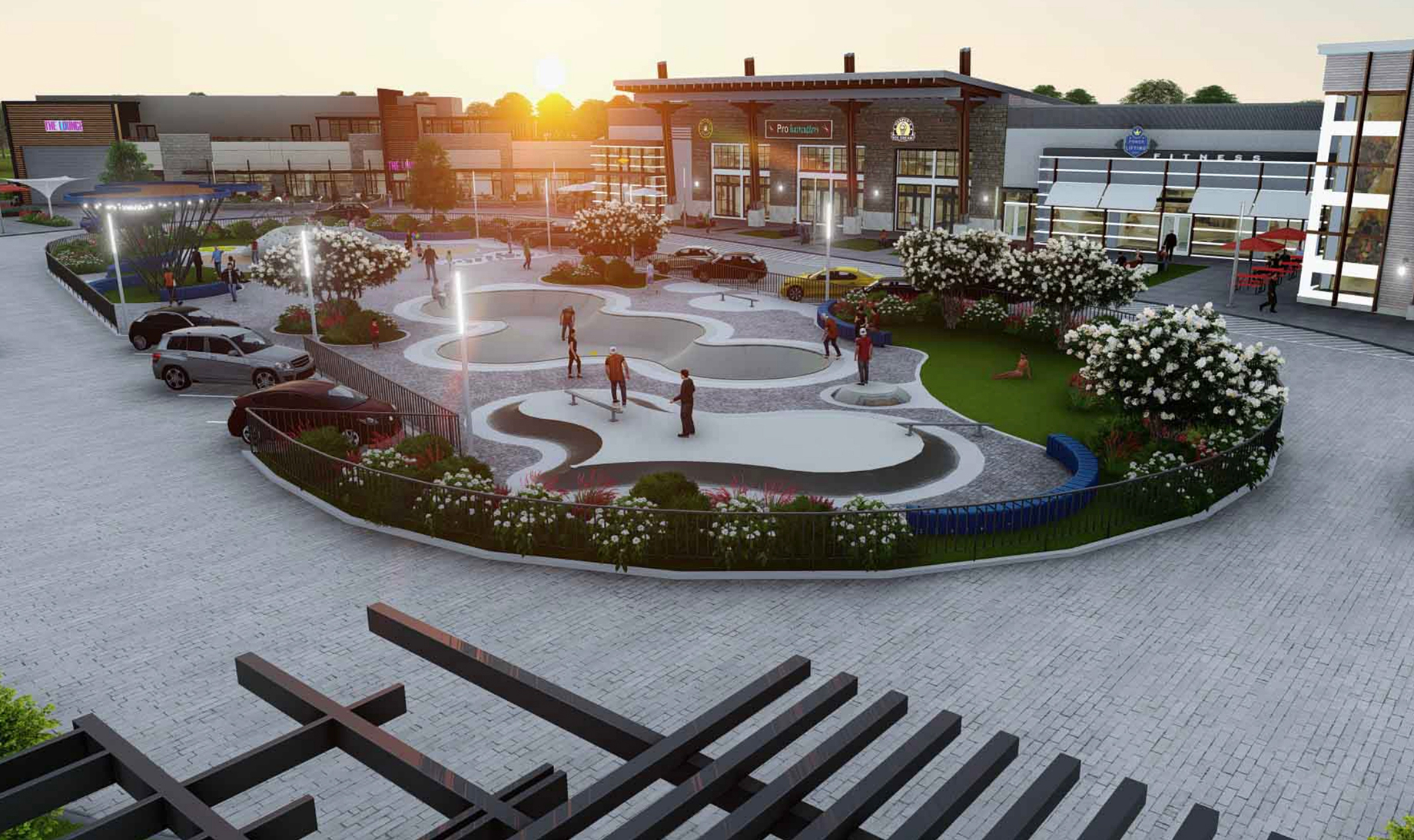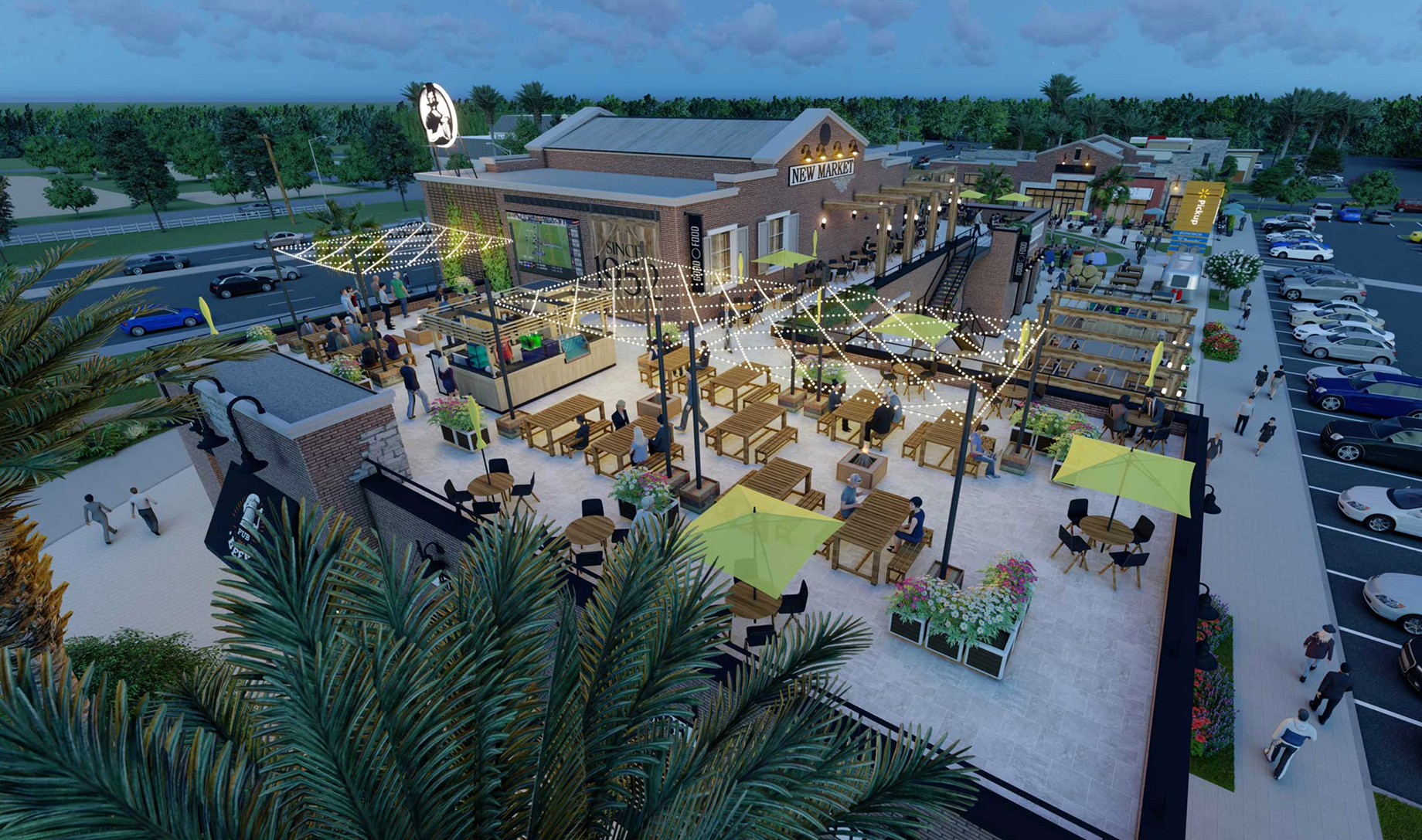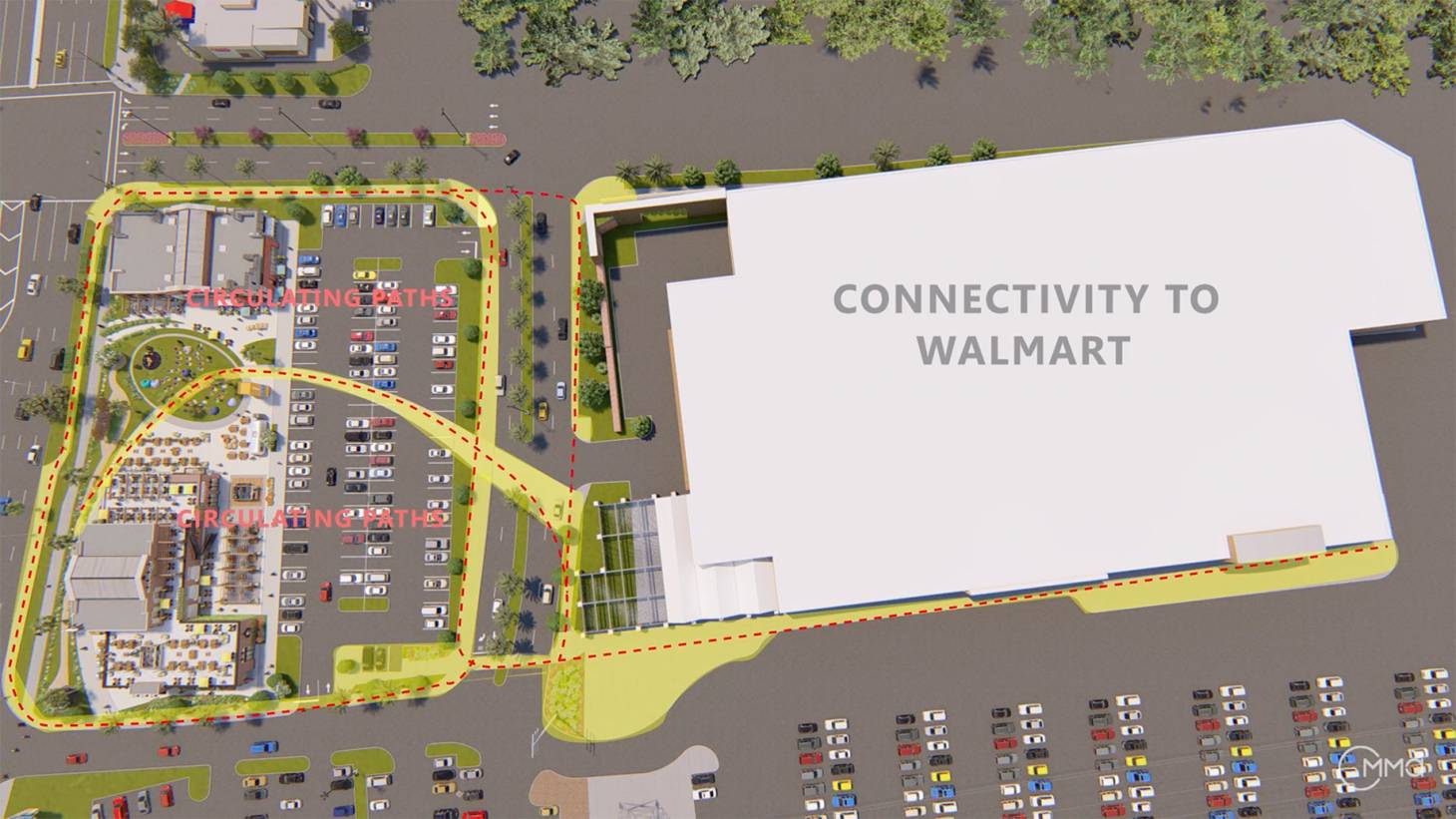Walmart is setting the stage to add town-center-style retail buildings to a dozen or more of its U.S. properties as part of its Walmart Reimagined campaign, which is aimed at reutilizing excess parking space and boosting store traffic.

Artist's rendering of potential development in a Walmart parking lot
The company is promoting these plans just as other large retailers are similarly pressing to extract additional revenue from their own existing real estate. Walmart unveiled its Walmart Town Center plan at the ICSC Southeast Conference & Deal Making, held in October in Atlanta, during a keynote speech by L.B. Johnson, Walmart’s vice president of U.S. realty operations. Since the announcement, though, the company seems to have walked back the status of the add-on buildings from imminent to conceptual.
Each town center will be customized to its community, offering combinations of shops, restaurants, entertainment providers, food halls, fitness centers, parks and diversified services providers, the company says. A video shown at the session featured such potential tenants as Chipotle Mexican Grill, Orangetheory Fitness, Pinstripes and Shake Shack. Pet stores, urgent-care centers and multifamily units were held out as possibilities too.
Design drawings were featured on the Walmart Reimagined website, which suggested that some of the new merchants could be occupying reused shipping containers. A Walmart representative told media that the centers remain “very much in the conceptual stage.”

Artist's rendering of potential development in a Walmart parking lot
Walmart said it planned to break ground on the first such center this coming spring, on six acres of parking space and 12 acres of vacant land at its Loveland, Colo., Supercenter, according to Johnson. Torchy’s Tacos, Wake & Bake, Wahlburgers and possibly a skate park could be among the tenants at the Loveland site. Kelly Jones, economic development director for the city of Loveland, says officials have met with Walmart about a new town-center prototype for the store in Loveland off Highway 34. As of late November those plans remained only formative. In general, Jones says, the idea of beautifying and activating oversized parking lots is “uplifting.”
Among other markets where Walmart is considering town centers are Rogers, Ark., near the Walmart headquarters; Garland, Texas; Gresham, Ore.; Long Beach, Calif.; and Springfield, Mo. Smaller off-site projects are slated for Walmart properties in Lucas, Texas; Fort Collins, Colo.; and Stockton, Calif., among other places.
It remains to be seen whether Walmart’s lower-density rural and suburban stores can benefit from attached town centers, says Nii Ahene, COO of CPC Strategy, a San Diego–based digital-marketing agency with a focus on retail. “This sort of repurposing is not only viable for Walmart, but [even] necessary for the retail giant to fortify its position against Amazon,” he said. Like other major retailers, Walmart knows it needs to evolve beyond mere product fulfillment into richer customer experiences to stay competitive, Ahene observes. “The town-center format takes this further by surrounding a retail location with amenities like fitness centers and dining, which are naturally more resistant to online disruption,” he said. Such projects would also help ensure that the stores are linked with complementary, traffic-driving tenants, Ahene says.
“Walmart wants to provide community space — areas for the community to dwell: a farmers market, an Easter egg hunt, trick-or-treating. We want to provide pedestrian connectivity from our box to the experiential zones that are planned on our footprint. We want to augment these experiences and activities with more food-and-beverage, with health-and-fitness, essential services and entertainment”
Johnson said at the conference in Atlanta that Walmart wants “to provide community space — areas for the community to dwell: a farmers market, an Easter egg hunt, trick-or-treating. We want to provide pedestrian connectivity from our box to the experiential zones that are planned on our footprint. We want to augment these experiences and activities with more food-and-beverage, with health-and-fitness, essential services and entertainment.” Looking across the country to evaluate these town-center opportunities, Walmart will “be tapping the talent, expertise and partnership from members of this community to support our efforts,” said Johnson.
Some observers are skeptical that such developments can really attract quality town-center-type tenants. Among these watchers is David Livingston, a Hawaii-based independent supermarket analyst. The idea of a Walmart town square may sound quaint, but there is more to it than that, Livingston argues. “In my opinion, these will be few and far between,” he said. “Most likely, anything done regarding Walmart will be done on the cheap, not the chic.” Other large retailers, including grocery chains, are actively parceling off excess parking space too, “but they are doing it for things less desirable or revolutionary,” such as car lots, storage facilities, clusters of food trucks and medical offices, according to Livingston.
But others seem confident that Walmart can at least blaze a trail with the idea. Walmart may not have pioneered this vision, these optimists say, but it is surely the largest retailer now in pursuit of it. And that, they assert, could make all the difference. Walmart “may very well spur an acceleration among the other major players who are defining their own strategies for building experiential communities,” noted Robin Lewis, a consultant for the retail and consumer-products industries, in his online Robin Report.

Kohl’s says it is working with a list of possible partners from the grocery and convenience channels to develop parking acreage at some 300 stores, while Macy’s points to about 50 of its stores that it thinks may be conducive to such parking-lot repurposing. The typical Macy’s tract measures about 20 acres.
Kimco Realty Corp. CEO Conor Flynn said in October that his firm, too, is looking at “activating underutilized parking fields,” in addition to retenanting 14 old Sears-Kmart buildings in the Kimco portfolio to create better rent spreads.
Walmart is reimagining its interiors as well, investing some $480 million in Florida and Texas to open 14 new stores and to remodel 82 others; about $145 million to remodel 34 units in California; $94 million to renovate 27 stores in Ohio; and $75 million to upgrade 14 stores in Virginia. Meanwhile, the company is investing millions more to help streamline customer-pickup systems for online-grocery purchases at about 1,000 U.S. store locations and to add customer-pickup towers at 500 others, according to published reports.
“Walmart hopes to slow the shift of wallet share to online competitors,” Ahene said. Such changes could ease Walmart’s order-fulfillment time considerably, “from two days to a matter of minutes,” according to Ahene. “This also eliminates the need to find a parking spot, navigate a store and stand in line to check out.”
The Walmart town-center concept is an example of the ways existing assets can be reimagined to help transform and boost the customer experience, Ahene says.
Johnson concurs, asserting: “A transformation is under way.”
By Steve McLinden
Contributor, Commerce + Communities Today


